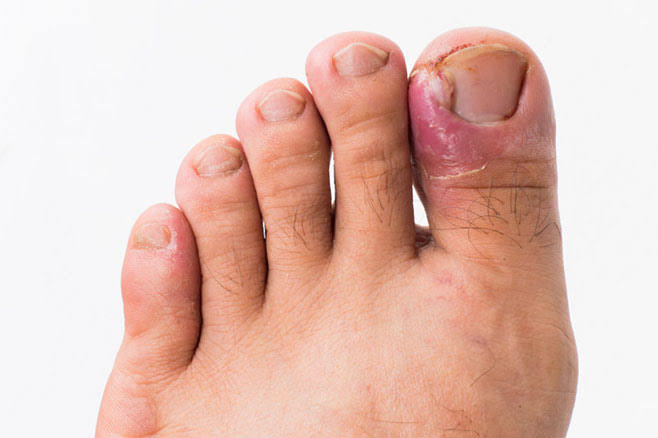
Ingrown Toenail
What is an Ingrown Toenail?
An ingrown toenail occurs when the nail grows out of its bed and into the surrounding skin, most commonly affecting the big toe. It is more prevalent in men than in women. Typically, the edges of the nail dig into the skin on the sides, but in some cases, the entire nail may become embedded in the nail bed. The body perceives the ingrown nail as a foreign object, triggering a series of reactions.
The initial symptoms of an ingrown toenail include redness, pain, and swelling. Bleeding may occur at the site, or an infection may develop, leading to pus. If left untreated, the infection can spread to the bone (osteomyelitis) or cause systemic infections.
What Causes an Ingrown Toenail?
Ingrown toenails can result from various causes, with the most common being improper nail trimming. Cutting the nail too short or rounding the edges excessively are frequent mistakes that cause the nail to grow into the skin.
Improper nail trimming
Wearing tight or pointed-toe shoes
Trauma to the toe or nail (e.g., impact or heavy objects falling on it)
Thickening of the nail
Obesity
Excessive foot sweating
Toenail fungus
Certain congenital anomalies
Diseases such as diabetes, rheumatoid arthritis, hyperthyroidism, or gout

What Are the Symptoms of an Ingrown Toenail?
The most common symptoms are pain, swelling, and redness, sometimes accompanied by purulent discharge. Diagnosis is typically made through a physical examination. In cases of severe or persistent infection, a wound culture may be taken to select the appropriate antibiotic, and an X-ray may be requested to check if the infection has spread to the bone.
How is an Ingrown Toenail Treated?
In early cases, non-surgical treatment is often sufficient.
The primary principle of ingrown toenail treatment is to allow the nail to grow past the toe without becoming embedded, which requires maintaining the natural groove between the nail edge and the skin to guide proper nail growth.
Non-Surgical Treatment Methods for Ingrown Toenails:
Use of antibiotic cream and/or oral antibiotics in the presence of infection
Placing a small piece of gauze soaked in antibiotic cream under the ingrown portion
Softening the nail with warm saltwater soaks
Avoiding tight or pointed-toe shoes
Maintaining proper foot hygiene
Surgical Treatment for Ingrown Toenails:
Surgical intervention is necessary in cases where the ingrown nail is large, the skin tissue has grown over the nail, or there is a persistent infection.
The surgical treatment method varies depending on the location and severity of the ingrown nail.
Nail removal is performed under local anesthesia, making it a painless procedure. Patients can walk home after the procedure.
In cases of ingrown toenails, either partial removal of the affected side (preserving the non-ingrown parts of the nail) or complete nail removal may be required. To prevent the nail from regrowing, the germinal matrix (where the nail is produced) can be destroyed using chemicals (e.g., phenol), cauterization, or laser (matrisectomy).
In addition to nail removal, it is crucial to remove overgrown skin tissue and revise the nail bed.
Post-procedure care of the newly growing nail and ensuring its normal growth are essential. Therefore, follow-up with a doctor is necessary until a normal nail forms.
You can click here to return to the homepage.
